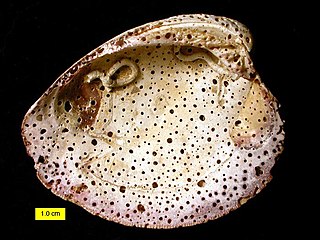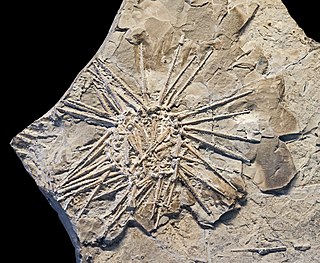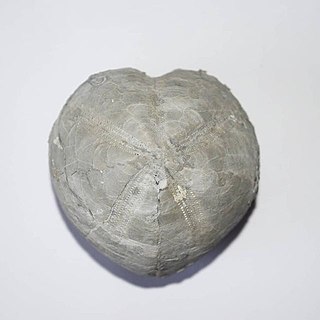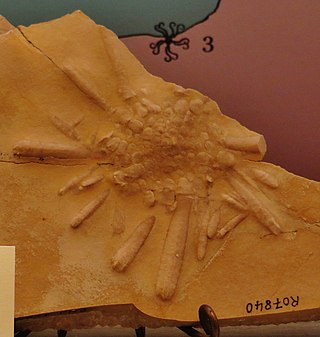
Sea urchins are spiny, globular echinoderms in the class Echinoidea. About 950 species of sea urchin live on the seabed of every ocean and inhabit every depth zone from the intertidal seashore down to 5,000 meters. The spherical, hard shells (tests) of sea urchins are round and covered in spines, ranging in length from 3 to 10 cm, though the black sea urchin can have spines as long as 30 cm (12 in). Sea urchins move slowly, crawling with tube feet, and also propel themselves with their spines. Although algae are the primary diet, sea urchins also eat slow-moving (sessile) animals. Predators that eat sea urchins include a wide variety of fish, starfish, crabs, marine mammals. Sea urchins are also used as food especially in Japan.

Bioerosion describes the breakdown of hard ocean substrates – and less often terrestrial substrates – by living organisms. Marine bioerosion can be caused by mollusks, polychaete worms, phoronids, sponges, crustaceans, echinoids, and fish; it can occur on coastlines, on coral reefs, and on ships; its mechanisms include biotic boring, drilling, rasping, and scraping. On dry land, bioerosion is typically performed by pioneer plants or plant-like organisms such as lichen, and mostly chemical or mechanical in nature.
A thunderstone is a prehistoric hand axe, stone tool, or fossil which was used as an amulet to protect a person or a building. The name derives from the ancient belief that the object was found at a place where lightning had struck.
Trace fossils are classified in various ways for different purposes. Traces can be classified taxonomically, ethologically, and toponomically, that is, according to their relationship to the surrounding sedimentary layers. Except in the rare cases where the original maker of a trace fossil can be identified with confidence, phylogenetic classification of trace fossils is an unreasonable proposition.

Archaeocidaris is an extinct genus of echinoid that lived from the Late Devonian to the Late Permian. Its remains have been found in Africa, Europe, and North America.

Hemicidaris is an extinct genus of echinoids that lived from the Middle Jurassic to the Early Cretaceous. Its remains have been found in Africa, Asia, and Europe.

Phymosoma is an extinct genus of echinoids that lived from the Cretaceous to the Eocene. Its remains have been found in Asia, Europe, and North America.

Coelopleurus is an extant genus of echinoids with fossil records dating back to the Eocene, with remains found in Europe and North America.
Linthia is an extinct genus of echinoids that lived from the Late Cretaceous to the Eocene. Its remains have been found in Africa, Asia, Europe, and North America.

Micraster is an extinct genus of echinoids from the Late Cretaceous to the early Eocene. Its remains have been found in Africa, Antarctica, Europe, and North America. Micraster was an infaunal echinoid living in a burrow below the sediment surface. The test is clearly bilateral and there is a deep anterior groove to take in water containing organic particles to the mouth. The tube feet keep a supply of nutrient-laden water moving into the burrow. The anus has a waste tube behind it.

Alligatorellus is an extinct genus of atoposaurid crocodyliform found in France that was related to Atoposaurus.
The Kallakurichi Formation, alternatively spelled as Kallankurichchi or Kallankurichi Formation, is a geological formation of the Ariyalur Group in Tamil Nadu, southern India whose strata date back to the Maastrichtian stage of the Late Cretaceous. Dinosaur eggs of Megaloolithus cylindricus are among the fossils that have been recovered from the sandy limestones of the formation.
Pelanechinus is an extinct genus of sea urchins in the order Echinothurioida. It is placed in the family Pelanechinidae and is in the stem group of echinoids.

Asterocidaris is a genus of fossils sea urchins in the family Hemicidaridae. These epifaunal grazer-deposit feeders lived in the Middle and Upper Jurassic age.
Tetragramma is a genus of fossil sea urchins known from the Upper Jurassic (Oxfordian) to the Upper Cretaceous (Turonian).
Tetragramma donaldtrumpi is a species of fossil sea urchins discovered and identified by William R. Thompson, Jr. in 2016. The specimen locality is from the Lower Cretaceous, Trinity Group, of the Glen Rose Formation near Fischer, Texas, in the United States.

The Kristianstad Basin is a Cretaceous-age structural basin and geological formation in northeastern Skåne, the southernmost province of Sweden. The sediments in the basin preserves a wide assortment of taxa represented in its fossil record, including the only non-avian dinosaur fossils in Sweden and one of the world's most diverse mosasaur faunas.

Echinoid fossils are the fossilised remains of sea urchins, spiny marine invertebrates that live on the seabed. Humans have been interested in these fossils for millennia, have considered them lucky, have imbued them with magical powers and linked them to their deities.












